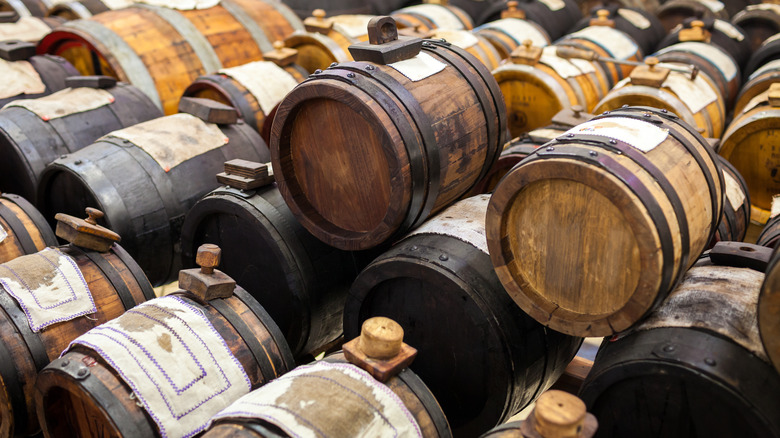What Exactly Goes Into The World's Most Expensive Balsamic Vinegar
In many ways, good balsamic vinegar is like good wine. There are intricacies and nuances to the way it's produced, as the more it ages, the more developed and complex it becomes, and things like origin and region matter — a lot. There's so much that goes into the good stuff.
What exactly is the good stuff? It's called Aceto Balsamico Tradizionale (DOP), and it's the highest quality — and therefore the most expensive — balsamic vinegar in the world. Similar to how true Champagne can only come from the Champagne region of France, true balsamic vinegar is only produced in Reggio Emilia or Modena, from the specific grapes that are native to those regions in Italy.
A tiny 100-ml bottle of this stuff (a little over 3 ounces) will easily cost you over $100, and the price tag can reach well past $200 for the very best kind. Do the math, and that'll run you around $30 for a tablespoon of this liquid goodness. So what makes it worth the money?
Aceto Balsamico Tradizionale: origin and technique
True Aceto Balsamico Tradizionale will indicate one of the two regions it comes from, so the bottle will either say "di Modena" or "di Reggio Emilia." The vinegar is made from wine grapes that grow in the designated region — most notably the Trebbiano and Lambrusco grapes, but other varieties can be used as long as they come from Modena or Reggio Emilia.
Once the grapes are harvested, their juice, skins, seeds, and stems are all pressed to create what's called "grape must." This is the only ingredient used to make traditional balsamic vinegar, and it's transformed from must into a thick, sweet vinegar through the use of a classic technique. The grape must is slowly boiled and simmered over an open fire for up to 30 hours, and then it's aged in wooden barrels.
With each year, the liquid reduces in volume by around 10% and as it ages, it's transferred into barrels that become smaller and smaller in size. This concentrates the flavors and draws out more notes and complexities of the wood. And here's what really seals the deal: by law, traditional balsamic vinegar must be aged a minimum of 12 years, with the most coveted bottles aged up to 25 years or more.
High quality balsamic vinegar means high quality standards
To be considered the best in the world, this balsamic has to meet the best possible standards. That's where the "DOP" on the label comes in. "DOP" stands for "Denominazione d'Origine Protetta", or "Protected Designation of Origin." This essentially means that the origin and production of the vinegar are regulated according to the highest quality standards, guaranteeing a top-tier final product that's been quality-checked every step of the way.
There's more about the bottle that will indicate its elevated standards. First, real traditional balsamic vinegar only has one ingredient: grape must. If there's anything else listed on the back of the bottle, it's most likely not balsamic vinegar "tradizionale." And you'll see different colors on the label that correspond to the aging process: red if it's been aged 12 years, silver if it's been aged 18 years, and gold if it's been aged 25 years.
Lastly, the distinct shape of the 100-ml bottles is meant to represent the product's authenticity. Aceto Balsamico Tradizionale di Modena comes in a spherical, bulbous shape (referred to as the "Giugiaro bottle"), which was designed by Italian car designer Giorgetto Giugiaro. Aceto Balsamico Tradizionale di Reggio Emilia comes in a bottle that looks like an upside-down tulip.



